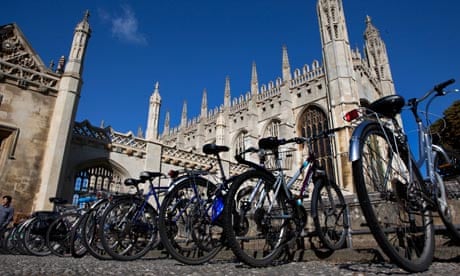Cambridge has taken the top spot in this year's Guardian University Guide league table, breaking its arch rival Oxford's six-year stint as the UK's leading institution.
Oxford has come second and St Andrews third, while the London School of Economics has climbed four places from last year to take fourth place.
University College London, Warwick, Lancaster, Durham, Loughborough and Imperial College make up the top 10.
The University Guide, published in full on the Guardian website on Tuesday, is based on data for full-time undergraduates at UK universities. The league table goes live on the website at midnight tonight.
Our analysis shows that universities with low rankings are almost as likely to be planning to charge maximum tuition fees of £9,000 in autumn 2012 as those with high rankings.
London Metropolitan University, which comes bottom of the Guardian tables, intends to charge between £4,500 and £9,000 for its degrees. Salford, Liverpool John Moores, Manchester Metropolitan and the University of East London – all of which rank in the bottom 20 – want to charge £9,000 for at least some of their courses.
The government's access watchdog, the Office for Fair Access, is looking at the fees each university in England wants to charge and will announce in July whether it approves.
All the English universities in our top 20 intend to charge £9,000 fees, apart from London School of Economics, which has not yet decided.
The first university that proposes to charge less than £9,000 for all of its courses is Sunderland, which is ranked 48th.
There are a total of 120 institutions in the tables: 38 in the top half intend to charge £9,000 for at least some of their courses, while 18 in the bottom half propose to do the same.
Universities are ranked according to how much they spend per student; their student/staff ratio; the career prospects of their graduates; what grades applicants need; a value-added score that compares the academic achievements of first-years and their final degree results; and how content final-year students are with their courses, based on the annual National Student Survey.
Birmingham City University has fallen most since last year – 24 places, from 66th to 90th – while Middlesex is the biggest climber, reaching 75th place this year compared with 112th last year. Durham has risen from 17th place to eighth.
While the oldest universities dominate the top positions in the tables, the newest have improved their rankings since last year. Winchester has leapt from 96th place to 69th.
The tables, compiled by an independent consultancy firm, Intelligent Metrix, are weightedin favour of the National Student Survey. As part of the survey, final-year students are asked to score their universities for overall satisfaction, feedback and contact hours. Other league tables concentrate more on research ratings.
The Guardian publishes an overall ranking table, separate tables to show which universities are best – and worst – for each subject and another table for specialist institutions.
The more a university spends on each student, the more likely it is to have a high ranking and the more satisfied its students seem. However, our judges took into account that some universities do not teach expensive courses, such as engineering, and so their spending is lower.
There is huge variation in how much universities spend per student, with an average of £3,428 in 2009-10 (a fall from the £3,495 the year before). At Oxford, average spend per student fell to £11,232 in 2009-10 from £11,410 the year before. The university spends substantially more than other institutions. Cambridge spent £8,612 in 2009-10, a rise from £8,118 the year before.
St Mary's University College in west London and Leeds Trinity University College spent among the lowest of all institutions per student.
The tables show that Cambridge has overtaken Oxford in philosophy, law, politics, theology, maths, classics, anthropology and modern languages. However, Oxford overtook Cambridge in psychology and also came top in chemistry, business and management, and art and design. Loughborough is best for sports science, while King's College London is top for dentistry. University College London topped the table for English, while Trinity Laban Conservatoire excelled for drama and dance. Northumbria has shot up the table for modern languages, from 48th last year to third this year.
Universities with high rankings tend to have fewer dropouts, and fewer students per academic. The top 20 institutions have a drop-out rate after the first year of just 4%, compared with almost 12% for the bottom 20.
There are 14.2 students per academic among the top 20, but 21.5 among the bottom 20. The smallest institutions tend to be ranked closer to the bottom.
Professor David Tidmarsh, vice-chancellor of Birmingham City University, says he expects his university's fall in position to be temporary: "It is caused by student number growth, which has now been curbed, and student satisfaction scores, which we expect to improve significantly as a consequence both of increased investment and of the way in which we are engaging students as partners in their learning experience."
He says the university is investing £180m in new buildings, facilities and equipment.
Swansea Metropolitan, Wolverhampton and Liverpool Hope did not allow the Guardian to use their data.
Meanwhile, the government has cut the number of places universities can offer on teacher training courses. Cambridge University, which comes top of our table for education courses, will have 49 fewer places on its teacher training course this September, an 11% cut. Altogether, almost 4,000 fewer places will be available on teacher training programmes.
A spokesman from the Department for Education says pupil numbers are falling sharply in secondary schools and so the need for new teachers has gone down.




Comments (…)
Sign in or create your Guardian account to join the discussion